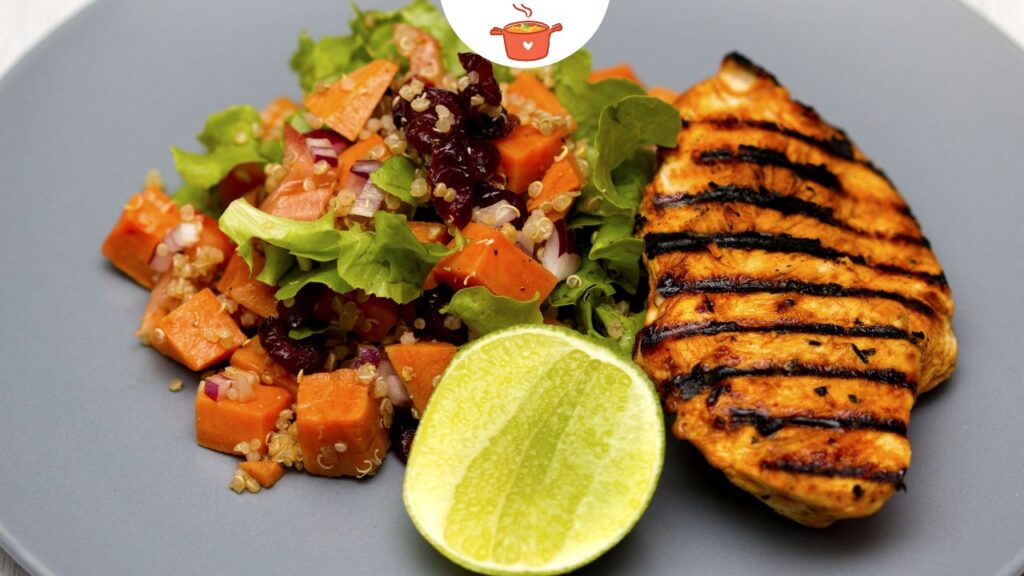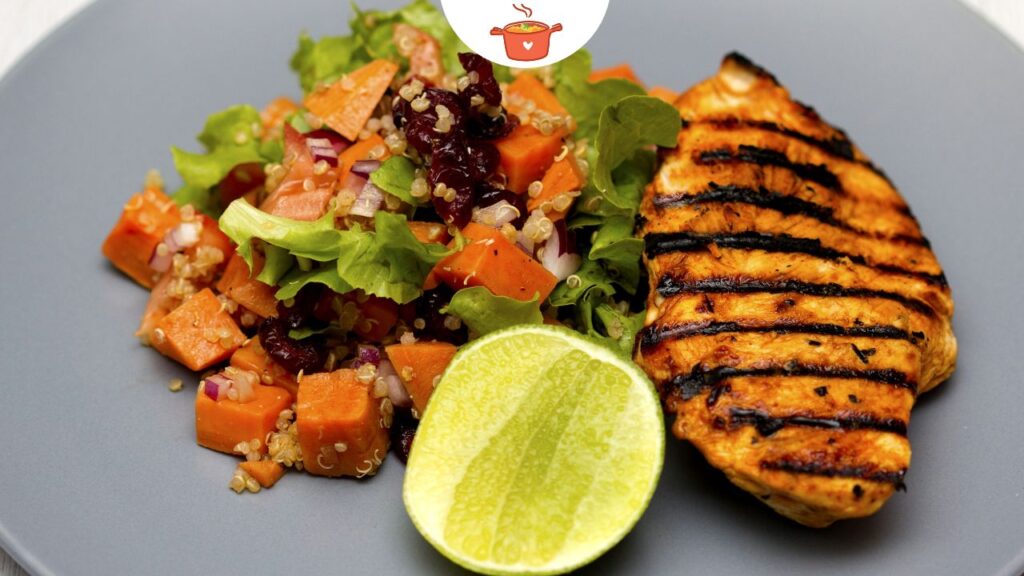
Have you ever bitten into a chicken breast only to find it dry and flavorless? Tips for cooking tender chicken breast can transform your meals from mediocre to mouthwatering. Whether you’re a busy home cook, a health enthusiast, or a culinary aficionado, mastering the art of cooking tender chicken breast is essential. Let’s explore the secrets to achieving juicy, succulent chicken breast that will impress your family and elevate your cooking game.
Contents
- 1 Understanding Chicken Breast Tenderness
- 2 Essential Tips for Cooking Tender Chicken Breast
- 3 Flavoring and Seasoning for Tender Chicken Breast
- 4 Step-by-Step Guide to Cooking Tender Chicken Breast
- 5 Common Mistakes to Avoid in Cooking Tender Chicken Breast
- 6 Advanced Tips and Techniques
- 7 Storing and Reheating Tender Chicken Breast
- 8 Frequently Asked Questions (FAQs)
- 9 Conclusion
- 10
Understanding Chicken Breast Tenderness
Definition
Tenderness in chicken breast refers to the meat’s ability to remain juicy and soft rather than becoming tough and dry during cooking. Achieving tender chicken breast involves understanding its structure and employing the right cooking techniques.
Anatomy of Chicken Breast
The chicken breast is a lean cut of meat with minimal fat, making it susceptible to drying out if not cooked properly. It consists mainly of the pectoral muscles, which are used frequently by the bird, contributing to their firmness. Understanding this muscle structure is key to preventing overcooking and ensuring tenderness.
Importance of Tender Chicken Breast
A tender chicken breast not only enhances the eating experience but also allows for greater versatility in recipes. Whether grilled, baked, or sautéed, tender chicken breast can be paired with a variety of sauces and sides, making it a staple in numerous dishes. Moreover, tender chicken breast is more enjoyable and satisfying, encouraging healthier eating habits by making lean protein more appealing.
Essential Tips for Cooking Tender Chicken Breast
Selecting the Right Chicken Breast
Quality and Freshness
Start with high-quality, fresh chicken breast. Fresh chicken tends to be juicier and more flavorful compared to frozen varieties, which can sometimes result in a drier texture. Look for chicken breasts that are plump and pink without any off smells or discoloration.
Bone-In vs. Boneless
Bone-in chicken breasts often retain more moisture during cooking due to the bone acting as a heat conductor, which can help prevent the meat from drying out. However, boneless chicken breasts are more versatile and easier to cook quickly, making them ideal for fast recipes. Choose based on your cooking method and desired texture.
Organic vs. Conventional
While organic chicken is raised without antibiotics and hormones, some people believe it tastes better and has a firmer texture. However, the tenderness primarily depends on the cooking technique rather than whether the chicken is organic. Focus on selecting fresh, high-quality chicken regardless of the label.
Preparing the Chicken Breast
Trimming and Pounding
Trim any excess fat or connective tissue from the chicken breast to ensure even cooking. Pounding the chicken breast to an even thickness using a meat mallet or rolling pin helps it cook uniformly, preventing the thinner parts from drying out while the thicker parts finish cooking.
Marinating
Marinating chicken breast not only infuses it with flavor but also helps in tenderizing the meat. Use acidic ingredients like lemon juice, vinegar, or yogurt in your marinade to break down proteins and enhance moisture retention. Marinate for at least 30 minutes, or overnight for deeper flavor and tenderness.
Brining
Brining involves soaking the chicken breast in a saltwater solution, which helps the meat absorb moisture and stay juicy during cooking. A basic brine consists of water, salt, and optional flavorings like herbs or spices. Brine the chicken for 30 minutes to a few hours, depending on the size of the breasts.
Cooking Methods for Tender Chicken Breast
Grilling
Grilling chicken breast can yield delicious, smoky flavors while keeping the meat tender. Key tips include:
- Preheat the Grill: Ensure the grill is hot before adding the chicken to sear the outside quickly.
- Use Medium Heat: Avoid high heat that can burn the exterior while leaving the inside undercooked.
- Cook Evenly: Flip the chicken breast halfway through cooking to ensure even heat distribution.
Baking
Baking is a straightforward method that can produce tender chicken breast when done correctly.
- Preheat the Oven: Set to 375°F (190°C) for optimal cooking.
- Use a Baking Dish: Arrange the chicken breasts in a single layer to allow even heat circulation.
- Cover or Baste: Covering the dish with foil or basting the chicken with its juices helps retain moisture.
Sautéing and Pan-Frying
Quick and efficient, sautéing or pan-frying chicken breast requires precise heat management.
- Use High Heat: Start with a hot pan to sear the chicken and lock in juices.
- Minimal Oil: Use just enough oil to prevent sticking without making the chicken greasy.
- Monitor Cooking Time: Cook each side for 5-7 minutes, depending on thickness, and avoid overcrowding the pan.
Sous Vide
Sous vide cooking involves sealing the chicken breast in a vacuum bag and cooking it in a temperature-controlled water bath.
- Precision Temperature: Cook at a precise temperature (e.g., 145°F/63°C) to ensure perfect tenderness.
- Long Cooking Time: Sous vide allows for extended cooking times without overcooking, maintaining juiciness.
- Finish with Searing: After sous vide, quickly sear the chicken in a hot pan for added flavor and texture.
Pressure Cooking
Pressure cooking can quickly tenderize chicken breast while retaining moisture.
- Minimal Liquid: Use just enough liquid to create steam, preventing the chicken from becoming soggy.
- Short Cooking Time: Cook chicken breast for about 8-10 minutes under pressure to achieve tenderness.
- Natural Release: Allow the pressure to release naturally to keep the chicken moist.
Temperature Control
Using a Meat Thermometer
A meat thermometer is an essential tool for ensuring chicken breast is cooked to the right temperature without overcooking. Insert the thermometer into the thickest part of the breast to get an accurate reading.
Optimal Internal Temperature
The safe internal temperature for cooked chicken breast is 165°F (74°C). However, removing the chicken from heat slightly before it reaches this temperature and allowing it to rest can result in perfectly tender and juicy meat.
Heat Distribution
Ensure even heat distribution by using the appropriate cookware and adjusting the heat as needed. Even cooking prevents parts of the chicken from drying out while others remain undercooked.

Resting the Chicken Breast
Why Resting is Important
Allowing the chicken breast to rest after cooking lets the juices redistribute throughout the meat, enhancing tenderness and flavor.
How Long to Rest
Let the chicken rest for about 5-10 minutes after cooking. This brief period ensures that the juices settle, making the meat more succulent.
Covering While Resting
Lightly cover the chicken with aluminum foil while it rests to retain heat without trapping excess moisture, which can lead to sogginess.
Avoiding Common Mistakes
Overcooking
Overcooking chicken breast is the most common mistake, leading to dry and tough meat. Use a meat thermometer to monitor the internal temperature and remove the chicken from heat as soon as it reaches 160°F (71°C).
Underseasoning
Proper seasoning is crucial for flavor and moisture retention. Don’t skimp on salt and spices, and consider marinating or brining to enhance taste and tenderness.
Skipping Resting Time
Skipping the resting period can result in juices running out when you cut into the chicken, making it less tender and flavorful. Always allow the chicken to rest after cooking.
Flavoring and Seasoning for Tender Chicken Breast
Essential Seasonings
Salt
Salt is essential not only for flavor but also for moisture retention. It helps the chicken retain juices during cooking. Season generously but balance it with other flavors.
Pepper and Spices
Pepper adds a subtle heat, while spices like paprika, garlic powder, and cumin can elevate the chicken’s flavor profile. Use a combination of spices to create depth and complexity in your dishes.
Herbs
Fresh and dried herbs like thyme, rosemary, oregano, and parsley complement chicken breast beautifully. They add aromatic flavors and can be incorporated into marinades, rubs, or sauces.
Marinade Recipes
Basic Marinade
Ingredients:
- 1/4 cup olive oil
- 2 tablespoons lemon juice
- 2 cloves garlic, minced
- 1 teaspoon dried oregano
- Salt and pepper to taste
Instructions:
- Combine all ingredients in a bowl.
- Add chicken breasts and coat evenly.
- Marinate for at least 30 minutes or overnight in the refrigerator.
Flavorful Marinade
Ingredients:
- 1/4 cup soy sauce
- 2 tablespoons honey
- 1 tablespoon sesame oil
- 1 tablespoon grated ginger
- 2 cloves garlic, minced
Instructions:
- Mix all ingredients in a bowl.
- Add chicken breasts and marinate for at least 30 minutes.
- For a deeper flavor, marinate overnight.
Creamy Marinade
Ingredients:
- 1/2 cup plain yogurt
- 2 tablespoons olive oil
- 2 cloves garlic, minced
- 1 tablespoon lemon juice
- 1 teaspoon paprika
- Salt and pepper to taste
Instructions:
- Combine all ingredients in a bowl.
- Add chicken breasts and ensure they are well-coated.
- Marinate for at least 1 hour, preferably overnight.
Enhancing with Sauces
Pan Sauces
After cooking the chicken, deglaze the pan with wine or broth, then add herbs and butter to create a rich, flavorful sauce that complements the tender chicken.
Cream-Based Sauces
Cream-based sauces like Alfredo or mushroom cream sauce add richness and moisture, enhancing the tenderness of the chicken breast. Simmer the sauce until it thickens and coats the chicken evenly.
Tomato-Based Sauces
Tomato-based sauces such as marinara or puttanesca provide a tangy and robust flavor that pairs well with tender chicken breast. The acidity in tomatoes helps to tenderize the meat further.
Step-by-Step Guide to Cooking Tender Chicken Breast

Grilling Tender Chicken Breast
- Preheat the Grill: Ensure the grill is hot before adding the chicken to sear the exterior.
- Oil the Grill Grates: Prevent sticking and promote even cooking by brushing the grates with oil.
- Cook Over Medium Heat: Avoid high heat that can burn the outside while leaving the inside undercooked.
- Monitor Cooking Time: Typically, grill chicken breast for 6-8 minutes per side, depending on thickness.
- Check Internal Temperature: Use a meat thermometer to ensure it reaches 165°F (74°C).
- Rest Before Serving: Allow the chicken to rest for about 5 minutes before slicing to retain juices.
Baking Tender Chicken Breast
- Preheat the Oven: Set to 375°F (190°C) for optimal baking.
- Prepare the Chicken: Season or marinate the chicken breasts as desired.
- Use a Baking Dish: Arrange chicken breasts in a single layer to ensure even cooking.
- Bake Until Done: Typically, bake for 20-25 minutes, depending on thickness.
- Check Temperature: Ensure the internal temperature reaches 165°F (74°C).
- Rest and Serve: Let the chicken rest for a few minutes before serving to lock in moisture.
Sautéing and Pan-Frying Tender Chicken Breast
- Heat the Pan: Use medium-high heat with a small amount of oil.
- Prepare the Chicken: Season and optionally pound the chicken to an even thickness.
- Cook Each Side: Sauté for 5-7 minutes per side, depending on thickness.
- Monitor Doneness: Use a meat thermometer to check for 165°F (74°C).
- Rest Before Serving: Allow the chicken to sit for a few minutes to retain juices.
Common Mistakes to Avoid in Cooking Tender Chicken Breast
Overcooking the Chicken Breast
Solution
Use a meat thermometer to monitor the internal temperature and remove the chicken from heat as soon as it reaches 160°F (71°C), allowing it to rest to 165°F (74°C).
Tip
Remove early: Taking the chicken off the heat just before it reaches the desired temperature helps prevent overcooking during the resting phase.
Not Allowing the Chicken to Rest
Solution
Always let the chicken rest for 5-10 minutes after cooking.
Benefit
Resting allows the juices to redistribute, making the chicken more succulent and flavorful.
Skipping the Marinating or Brining Process
Solution
Incorporate at least a 30-minute marinade or brine before cooking.
Advantage
Marinating or brining enhances flavor and moisture retention, resulting in a more tender chicken breast.
Using Low-Quality Meat
Solution
Choose fresh, high-quality chicken breasts for better results.
Benefit
Higher quality meat tends to be more tender and flavorful, making your dishes more enjoyable.
Advanced Tips and Techniques
Infusing Flavors
- Stuffing Chicken Breast: Add herbs, cheese, or vegetables inside the chicken for an extra flavor boost.
- Using Compound Butter: Top cooked chicken with herbed butter for added richness and moisture.
Sous Vide Cooking
Benefits: Precise temperature control ensures perfect tenderness every time.
Method:
- Seal Chicken Breasts: Place in a vacuum-sealed bag with seasonings.
- Cook in Water Bath: Sous vide at 145°F (63°C) for 1-2 hours.
- Finish with Searing: Quickly sear in a hot pan for flavor and texture.
Pressure Cooking
Advantages: Quick and effective in retaining moisture.
Technique:
- Add Minimal Liquid: Use just enough to create steam.
- Cook Under Pressure: Typically 8-10 minutes for tender results.
- Natural Release: Allow the pressure to release naturally to keep the chicken moist.
Alternative Cooking Methods
- Poaching: Gently cook chicken in simmering liquid to keep it moist and tender.
- Slow Cooking: Use a slow cooker to tenderize chicken breasts over several hours with minimal effort.
Storing and Reheating Tender Chicken Breast
Proper Storage
- Refrigeration: Store cooked chicken breasts in airtight containers for up to 4 days.
- Freezing: Freeze cooked chicken in freezer-safe bags or containers for up to 3 months.
Reheating Techniques
- Oven Reheating: Cover with foil and heat at 350°F (175°C) until warmed through.
- Microwave: Use a microwave-safe cover to retain moisture, heating in short intervals.
- Stovetop: Gently reheat in a skillet with a splash of water or broth to keep the chicken moist.
Maintaining Tenderness During Storage
- Avoid Overcooking: Reheat gently to prevent drying out.
- Moisture Retention: Add a bit of liquid when reheating to keep the chicken juicy.
Frequently Asked Questions (FAQs)
1. How can I prevent chicken breast from drying out?
To prevent chicken breast from drying out, avoid overcooking by using a meat thermometer to reach an internal temperature of 165°F (74°C). Marinate or brine the chicken beforehand, and allow it to rest after cooking to retain its juices.
2. What is the best internal temperature for tender chicken breast?
The best internal temperature for tender and safe-to-eat chicken breast is 165°F (74°C). However, removing it from heat slightly before it reaches this temperature and allowing it to rest can ensure maximum tenderness and juiciness.
3. Can brining chicken breast make it more tender?
Yes, brining chicken breast helps it retain moisture during cooking, resulting in a juicier and more tender texture. A basic brine consists of water, salt, and optional flavorings like herbs or spices.
4. How long should chicken breast rest after cooking?
Chicken breast should rest for about 5-10 minutes after cooking. This resting period allows the juices to redistribute throughout the meat, enhancing tenderness and flavor.
5. What marinades work best for tender chicken breast?
Marinades that include acidic ingredients like lemon juice, vinegar, or yogurt help tenderize chicken breast. Adding herbs, garlic, and spices also infuse flavor, making the chicken more succulent and tasty.
6. Is it better to cook chicken breast covered or uncovered?
Cooking chicken breast uncovered allows excess moisture to evaporate, which can help in browning and developing flavor. However, covering it with a lid or foil can retain moisture, which is beneficial for certain cooking methods like baking.
7. How does cooking time affect the tenderness of chicken breast?
Cooking chicken breast for too long can cause it to become dry and tough. Conversely, undercooking can leave it raw and unappetizing. Finding the right balance by monitoring cooking times and temperatures is crucial for achieving tender results.
8. What are the common mistakes when cooking chicken breast?
Common mistakes include overcooking, not marinating or brining, uneven thickness leading to uneven cooking, and skipping the resting period. These errors can result in dry, tough, and flavorless chicken breast.
Conclusion
Mastering tips for cooking tender chicken breast can significantly elevate your culinary skills, ensuring every meal is juicy, flavorful, and satisfying. By understanding the importance of ingredient selection, proper preparation, precise cooking techniques, and effective seasoning, you can consistently achieve perfect results. Whether you prefer grilling, baking, sautéing, or exploring advanced methods like sous vide, these tips will guide you toward creating tender chicken breast that delights your taste buds and impresses your guests. Embrace these strategies in your kitchen, experiment with different flavors and techniques, and enjoy the rewards of perfectly cooked chicken breast every time. Happy cooking!

